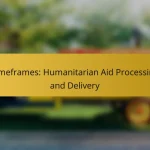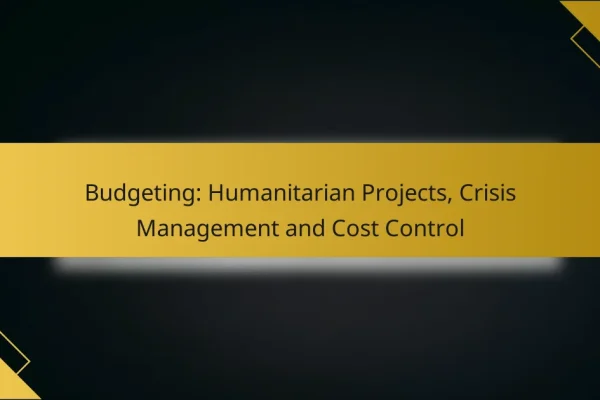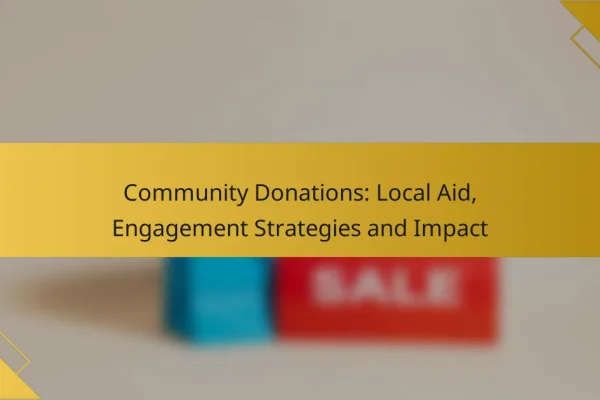What are the main funding sources for humanitarian aid?
The main funding sources for humanitarian aid include government grants, international organizations, private donations, corporate sponsorships, and nonprofit fundraising. Each source plays a crucial role in providing financial support to address urgent needs in crisis situations.
Government grants
Government grants are often the largest source of funding for humanitarian aid, typically allocated through national budgets or international aid programs. These grants can come from various levels of government, including local, state, and federal entities.
To access government grants, organizations must usually meet specific eligibility criteria and submit detailed proposals outlining their intended use of funds. It is essential to stay informed about application deadlines and reporting requirements to ensure compliance.
International organizations
International organizations, such as the United Nations and the World Bank, provide significant funding for humanitarian efforts worldwide. They often distribute funds through established programs that target specific crises or regions.
Working with these organizations can enhance credibility and provide access to additional resources. However, organizations must adhere to strict guidelines and reporting standards set by these entities to receive and maintain funding.
Private donations
Private donations from individuals can be a vital source of funding for humanitarian aid. Many people contribute to causes they are passionate about, often through online platforms or fundraising events.
To maximize private donations, organizations should focus on building strong relationships with donors and maintaining transparency about how funds are used. Regular updates and impact reports can encourage continued support and engagement.
Corporate sponsorships
Corporate sponsorships involve partnerships between humanitarian organizations and businesses that provide financial support in exchange for brand visibility or social responsibility alignment. These partnerships can be mutually beneficial, enhancing the organization’s reach while promoting the company’s commitment to social causes.
When seeking corporate sponsorships, it is crucial to align with companies whose values match the organization’s mission. Clear agreements outlining expectations and deliverables can help ensure a successful partnership.
Nonprofit fundraising
Nonprofit fundraising encompasses various strategies to generate funds for humanitarian aid, including events, campaigns, and grant writing. Nonprofits often rely on a mix of funding sources to sustain their operations and support their missions.
Effective fundraising requires a well-defined strategy, including identifying target audiences and creating compelling messaging. Utilizing social media and community engagement can significantly enhance fundraising efforts and expand the donor base.
How do government grants support humanitarian efforts?
Government grants play a crucial role in supporting humanitarian efforts by providing essential funding to organizations that address crises and aid vulnerable populations. These grants can cover various expenses, including operational costs, project implementation, and emergency response initiatives.
Federal funding programs
Federal funding programs are typically administered by agencies such as the U.S. Agency for International Development (USAID) and the Department of State. These programs often focus on specific areas like disaster relief, health initiatives, and food security. Organizations can apply for grants through competitive processes, which may require detailed proposals outlining project goals and expected outcomes.
Examples of federal funding include the Emergency Food and Shelter Program and the Global Health Security Agenda. These programs provide substantial financial support, often ranging from thousands to millions of dollars, depending on the project’s scope and urgency.
State and local grants
State and local grants offer additional funding opportunities for humanitarian efforts tailored to community needs. These grants are often administered by state agencies or local governments and can focus on issues such as housing assistance, public health, and education. The application process may be less competitive than federal grants, allowing smaller organizations to secure funding more easily.
For instance, a local health department may provide grants for initiatives aimed at improving mental health services in underserved areas. Funding amounts can vary widely, typically from a few thousand to several hundred thousand dollars, depending on the program and locality.
International aid agreements
International aid agreements involve collaboration between governments and international organizations to provide humanitarian assistance across borders. These agreements can facilitate funding through multilateral organizations like the United Nations or regional bodies such as the European Union. They often address large-scale crises, such as refugee situations or natural disasters.
Countries may commit funds as part of international agreements, which can lead to substantial financial resources being allocated for humanitarian efforts. These agreements often require compliance with specific regulations and reporting standards to ensure transparency and accountability in the use of funds.
What role do international organizations play in funding?
International organizations play a crucial role in funding humanitarian aid by providing financial resources, expertise, and coordination among various stakeholders. They mobilize funds from member states, private donors, and other sources to support relief efforts in crisis situations.
United Nations funding mechanisms
The United Nations (UN) employs several funding mechanisms to support humanitarian initiatives globally. Key sources include the Central Emergency Response Fund (CERF), which provides rapid funding for emergencies, and various UN agencies like UNICEF and the World Food Programme that manage specific aid projects.
These mechanisms often require a detailed proposal process, and funds are typically allocated based on assessed needs in affected regions. For instance, during a natural disaster, the UN may prioritize funding for food security and shelter, ensuring that resources are directed where they are most needed.
World Bank initiatives
The World Bank contributes to humanitarian funding through initiatives aimed at poverty reduction and resilience building. Programs like the International Development Association (IDA) offer concessional loans and grants to low-income countries, enabling them to respond effectively to crises.
World Bank funding often focuses on long-term recovery and development, which can include infrastructure rebuilding and economic support. Countries may receive financial assistance contingent on implementing specific reforms or strategies to enhance resilience against future disasters.
Regional development banks
Regional development banks, such as the Asian Development Bank (ADB) and the African Development Bank (AfDB), provide targeted funding for humanitarian efforts within their respective regions. These banks often collaborate with local governments to address specific needs, such as health care and education during crises.
Funding from regional banks may come in the form of loans, grants, or technical assistance. They typically emphasize projects that foster regional stability and economic growth, which can be crucial in post-crisis recovery efforts. Engaging with these banks can offer countries access to specialized knowledge and resources tailored to their unique challenges.
How can private donations impact humanitarian aid?
Private donations play a crucial role in humanitarian aid by providing essential funding that can be quickly mobilized to address urgent needs. These contributions can significantly enhance the effectiveness and reach of aid organizations, allowing them to respond promptly to crises and support vulnerable populations.
Crowdfunding platforms
Crowdfunding platforms enable individuals to contribute directly to specific humanitarian projects, often with minimal barriers to entry. These platforms allow organizations to showcase their initiatives and gather funds from a wide audience, which can lead to substantial financial support for targeted efforts.
Popular crowdfunding sites like GoFundMe or Kickstarter can be effective for raising awareness and funds for specific causes. Organizations should create compelling narratives and use engaging visuals to attract potential donors and encourage sharing across social media.
Major donor contributions
Major donor contributions typically involve significant financial support from individuals, foundations, or corporations. These donations can provide a stable funding source for humanitarian organizations, allowing them to plan long-term projects and allocate resources effectively.
Building relationships with major donors often requires personalized outreach and clear communication about the impact of their contributions. Organizations should demonstrate transparency and accountability to foster trust and encourage ongoing support.
Community fundraising events
Community fundraising events are local initiatives that engage individuals in raising money for humanitarian causes. These events can range from charity runs to bake sales, creating a sense of community involvement and shared purpose.
Successful community events often rely on volunteer support and local partnerships. Organizations should promote these events through social media and local networks to maximize participation and donations. Setting clear fundraising goals can motivate participants and enhance the overall impact of the event.
What are the criteria for selecting funding sources?
Selecting funding sources for humanitarian aid involves evaluating several key criteria to ensure alignment with the organization’s goals and the reliability of the funding. These criteria help organizations prioritize sources that will effectively support their mission and sustain their operations.
Alignment with mission
Funding sources should align closely with the humanitarian organization’s mission and values. This ensures that the funds are used in ways that reflect the organization’s goals, whether that be disaster relief, health care, or education. For example, a group focused on health initiatives may seek funding from health-focused foundations or government programs.
Organizations should assess potential donors’ priorities and past funding patterns to ensure compatibility. A mismatch can lead to conflicts in project direction or mission drift, which can undermine the organization’s credibility and effectiveness.
Funding reliability
Reliability of funding sources is crucial for the sustainability of humanitarian efforts. Organizations should consider the track record of potential funders regarding timely disbursement and the consistency of their support. Reliable funding sources often have a history of fulfilling commitments, which can provide a stable financial foundation.
It is advisable to diversify funding sources to mitigate risks associated with dependency on a single donor. This can include a mix of government grants, private donations, and corporate sponsorships to ensure a steady flow of resources.
Geographic focus
The geographic focus of funding sources can significantly impact the effectiveness of humanitarian aid. Organizations should prioritize funding from sources that have a vested interest in the regions where they operate. Local foundations or international agencies with regional expertise often understand the specific challenges and needs of the area.
Additionally, understanding the regulatory environment and funding requirements in specific countries is essential. Some donors may have restrictions on how funds can be used based on local laws or operational guidelines, which can affect project implementation.
How do corporate sponsorships enhance humanitarian projects?
Corporate sponsorships significantly enhance humanitarian projects by providing essential funding and resources. These partnerships can amplify the reach and impact of initiatives, enabling organizations to deliver aid more effectively and efficiently.
Brand partnerships
Brand partnerships in humanitarian aid involve collaborations between non-profit organizations and businesses to achieve shared goals. These partnerships can lead to increased visibility, access to new audiences, and additional financial support for humanitarian efforts.
When forming brand partnerships, it is crucial to align values and missions. Companies should choose non-profits that reflect their corporate social responsibility goals, ensuring a genuine connection that resonates with both their customers and the communities served.
For example, a food company might partner with a humanitarian organization focused on hunger relief, providing both funding and products. This collaboration not only supports the cause but also enhances the brand’s reputation and customer loyalty.












